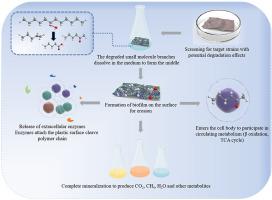Chemosphere ( IF 8.1 ) Pub Date : 2022-10-25 , DOI: 10.1016/j.chemosphere.2022.136978 Hui Wu 1 , Qiang Liu 1 , Wenxiao Sun 2 , Yahong Lu 3 , Yanjiao Qi 4 , Hong Zhang 5

|
Discarded polyethylene (PE) mulch film has led to persistent agricultural pollution. Biodegradation of plastic waste is considered as a promising solution that can potentially overcome environmental and economic problems. In this study, a novel bacterium (Bacillus paramycoides) was isolated from a waste mulch recycling plant and showed an extraordinary ability to customize polyethylene film. It was observed by scanning electron microscopy that a large number of pits and wrinkle cracks existed on the polyethylene, indicating that the strain used PE film as the sole carbon source. Meanwhile, the loss of weight of the film was tested continuously, and approximately 12% of the initial weight of the film was found to be lost within 45 days after coincubation with TW-2. The surface hydrophobicity of the polyethylene film decreased while the surface tension increased from 9.755 to 31.013. Fourier transform infrared (FTIR) analysis indicated that absorption peaks near 1740 cm−1 and 2760 cm−1 were attributed to the stretching vibrations of aldehyde and carboxyl groups, respectively, suggesting that hydrophilic groups were produced. This was also confirmed by XPS spectroscopy analysis. X-ray diffraction (XRD) analysis also showed that the relative crystallinity decreased from 33% to 11.51%. In addition, GPC analysis showed that the molecular weight decreased, while the proportion of low molecular weight fragments increased. These results strongly indicated that the PE film was able to be degraded to some extent by the strain. Finally, a new biodegradable mechanism for polyethylene was proposed.
中文翻译:

副丝状芽孢杆菌对聚乙烯地膜的生物降解性
废弃的聚乙烯(PE)地膜导致了持续的农业污染。塑料废物的生物降解被认为是一种有前景的解决方案,有可能克服环境和经济问题。在这项研究中,从废弃地膜回收工厂中分离出一种新型细菌(副丝状芽孢杆菌),它表现出定制聚乙烯薄膜的非凡能力。扫描电镜观察发现,聚乙烯上存在大量凹坑和皱纹裂纹,表明该菌株以PE薄膜为唯一碳源。同时,连续测试薄膜的重量损失,发现与TW-2共孵育后45天内薄膜损失了约12%的初始重量。聚乙烯薄膜的表面疏水性下降,表面张力从9.755增加到31.013。傅里叶变换红外(FTIR)分析表明,1740cm -1和2760cm -1附近的吸收峰分别归因于醛基和羧基的伸缩振动,表明产生了亲水基团。XPS 光谱分析也证实了这一点。X射线衍射(XRD)分析还表明相对结晶度从33%下降到11.51%。另外,GPC分析表明分子量下降,而低分子量片段的比例增加。这些结果强烈表明,PE 膜能够在一定程度上因应变而降解。最后,提出了一种新的聚乙烯生物降解机制。































 京公网安备 11010802027423号
京公网安备 11010802027423号